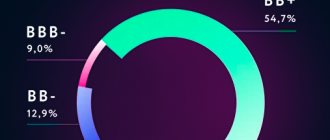Greetings! Why is inflation dangerous? Not only because food and clothing become more expensive every month. Inflation little by little eats up savings over long periods. Perhaps, this is the only thing that forces conservative investors to invest money in instruments with an optimal ratio of profitability and risk.
In a crisis, the minimum task of a cautious investor comes down to the following: preserve capital, compensate for losses from inflation and earn at least something on top.
There are sadly few truly reliable instruments with returns above the inflation rate in Russia. And I want to talk about one of them today. Please love and favor: OFZ-IN 52001 – Russian “anti-inflationary” bonds!
All OFZ with indexed denomination
| Name | Profitability | Price | Years to maturity | Coupon, rub | NKD, rub | Coupon payment date | maturity date |
| OFZ 52001 | 1.7% | 101.85 | 2.3 | 16.15 | 8.14 | 2021-08-18 | |
| OFZ 52002 | 2.7% | 99.19 | 6.7 | 14.28 | 7.74 | 2021-08-11 | |
| OFZ 52003 | 2.7% | 98.75 | 9.2 | 12.98 | 8.03 | 2021-07-28 |
What are the advantages and when should you buy them?
OFZ-IN bonds are not some kind of social experiment; they are a centuries-tested means of protecting deposits with a well-functioning mechanism that does not at all resemble an “equation with many unknowns.”
Advantages, according to reviews from holders of this type of bonds:
- investors are insured against inflation risks in the event of sudden changes in purchasing power as a result of “acceleration” of prices;
- OFZ-IN bonds have greater price security compared to OFZ with a constant coupon; they can be sold to other investors at a currently favorable price without fear of “losing”;
- It is beneficial to keep part of your savings in these debt securities in order to diversify (diversify) deposits;
- OFZ-IN bonds can be used without fear by non-residents (the ruble exchange rate and the inflation rate are usually proportional).
FACT. The result of the purchase of such securities is predetermined by their original purpose: “to save money” by beating the machinations of inflation.
Thus, purchasing OFZ-IN bonds is most appropriate in unstable economic conditions, which, as a rule, are not short-term.
How is the rate calculated?
OFZ-IN provides a coupon income of 2.5% per annum. The value is unchanged; the basis for calculations is the amount of the denomination on certain dates.
As the par value of bonds increases, their profitability changes.
The denomination increases during inflation and decreases during deflation.
To identify the level of change in the value of money, the consumer price index, which is published by Rosstat, is analyzed.
Structure
OFZ-IN – Federal Loan Bonds with an Indexed Nominal value, whose rate will change depending on the level of inflation. Such OFZs are used to protect money from depreciation.
OFZ-INs enjoy extremely low interest among private investors, and the main holders are most often mutual funds or companies that hold a small part of free money in such OFZs as a protective investment. The number of OFZ-IN issues, according to the website bonds.finam.ru, is only 3 out of 54 issues of all OFZ in circulation.
The volume of money in OFZ-IN is 4.0% of the total volume of the OFZ market.
OFZ-IN has a similar structure to OFZ-AD, but in one the nominal value increases, and in the other it decreases accordingly.
From the moment of placement until maturity, the coupon yield remains unchanged, most often 2.5%, and the nominal value increases by % inflation. After the par value increases, coupon income is accrued in a larger amount, albeit at the same interest rate.
rice. Change in nominal value and coupon income with inflation of 5% per annum
Using OFZ-52001-IN as an example, coupon payments look like this:
Example of denomination indexing
Indexation is carried out according to the following formula:
Ni = N * CPIgm/CPCgn, where:
- Ni – indexed denomination for a specific date;
- N – amount of face value at issue;
- CPIgm – consumer price index in 2000 prices for the month in which the cost is adjusted;
- CPIgn – consumer price index in 2000 prices on the day of placement.
For example, the nominal value on the date of placement of OFZ-IN was 1,000 rubles. The CPI in 2000 prices on the day the placement began was 487.8. If we index the denomination of a security for August 2015, then we take into account data for May 2000. CPI in 2000 prices for May 2015 – 489.5.
The nominal value of OFZ-IN as of 09/01/2015 will be:
Ni = 1000 * 489.5/487.8 = 1003.49 rubles.
Inflation Protected Bonds
The most reliable investment instrument in every country is government bonds. As a rule, they are the lowest-income instrument. And this low yield greatly reduces the attractiveness of such bonds for investors.
The state issues bonds not for investors, but for itself. If no one buys them, then budget revenues will decrease. We will have to curtail some government programs or raise taxes. Both causes discontent among the population.
If the government desperately needs to replenish its budget, but the economic situation leaves much to be desired and investors are not interested in buying low-yielding government bonds due to the future depreciation of these investments, the government may decide to issue special inflation-protected bonds.
Such bonds guarantee a small return above inflation. For example, 1% per annum. Then if inflation is 3%, investors will receive 4%. With inflation of 7%, the investor's return will be 8%.
Such bonds first appeared in Europe in 1946. Finland became the pioneer. The economy after the war is in ruins, the state needs income for various payments to victims, restoration of infrastructure, conversion of the military industry... The budget cannot be replenished with taxes - the income of the population and business is already small. Nobody wants to buy ordinary bonds in the face of widespread rising prices, so the state had to guarantee protection of savings from inflation.
At the turn of the 20th and 21st centuries, such bonds gained worldwide recognition. They are produced by many developed countries (Europe, USA).
In English, such issues are called “Inflation-linked Bonds”. In the USA, an analogue of such securities are TIPS - Treasury Inflation Protected Securities. In 2015, against the background of the economic crisis, devaluation of the ruble and lack of access to cheap Western loans due to sanctions, the Russian Government issued similar bonds on our market.
Which edition is better and how to choose it
There are currently 2 issues of OFZ-IN. Their numbers are 52001 and 52002. For both issues, the denomination is 1000 rubles. The coupon income is equal to 2.5% per annum and is paid twice a year. Their issue volumes are 150 billion rubles each.
The start date of placement of issue 52001 is 07/17/2015, its maturity date is 08/16/2023.
Issue 52002 has been placed since 03/21/2018, and its maturity date is 02/02/2028.
The choice of issue depends on the maturity of the bond and the time you plan to hold it. OFZ-IN are considered a good investment. They should also be purchased to diversify risks. Such bonds will provide good returns with very little risk.
If you do not plan to withdraw money in the near future, then the obvious choice is 52002. However, if there is uncertainty, you can buy 52001, wait for the maturity date, and then decide whether you want to continue investing in such an asset.
OFZ-IN of both issues can be sold ahead of schedule on the secondary market.
Benefit
The main parameter of OFZ-IN is saving money from inflation, and only after that is profitability, but it also happens that they are ahead of OFZ-PD. For such bonds it is very easy to calculate the “net” profit, that is, profit taking into account inflation, but it is impossible to predict it in the long term.
Let's compare OFZ-52001-IN with OFZ-26215-PD. They were issued with a difference of 2.2 years, and will be repaid on 08/16/2023.
OFZ-26215 – placed on 09/04/2013, par value 1000 and coupon 7%.
Table Coupon payment amounts
Let’s imagine that both securities were purchased at the time of issue and will remain in the investor’s account until November 13, 2020. By this time we have:
| OFZ-PD | OFZ-IN | |
| Purchase cost, rub. | 1000 | 1000 |
| Current value, rub. | 1059 | 1275 |
| Yield to maturity, % | 4,73 | 1,85 |
| Amount of coupons received, rub. | 487,3 | 145,5 |
On 11/13/2020 we decide to sell both securities and calculate the profit:
- The total profit on OFZ-PD for 7 years and 2 months amounted to 546.3, which is equal to 7.62% per annum.
- The total profit on OFZ-IN for 5 years and 4 months amounted to 420, which is equal to 7.9% per annum.
The convenience of using OFZ-IN also lies in the fact that due to the low coupon yield, these bonds have low volatility, so it is almost impossible to find OFZ-IN with a market value higher than 2.5% of the nominal value.
OFZ-IN is beneficial for both the investor and the issuer. The issuer pays 2.5% + % inflation, he does not need to guess inflation 20 years in advance, and then pay high % if inflation decreases.
The investor also does not need to worry about rising inflation; he knows in advance that regardless of the level of inflation, he will consistently receive 2.5% per year.
Advantages and disadvantages
Advantages of OFZ-IN:
- protection against inflation, since the indexed denomination insures against price increases in the future;
- any OFZ are in steady demand and are considered the most reliable instrument on the securities market, and with an indexed nominal value, bonds become even more popular and win-win;
- OFZ-IN allows you to get a stable income regardless of inflation processes; in terms of reliability and liquidity, it has advantages over other OFZs: with constant (fixed) income (FD), variable coupon (VC), with debt amortization (AD).
Disadvantages of OFZ-IN:
- inability to reinvest income, since inflationary income will appear only if bonds are sold or redeemed;
- For investors who take high risks in anticipation of high returns (usually associated with speculative securities), this is not the best investment option.
Comparison of OFZ-IN and OFZ-PD
Let us conduct a comparative analysis of the yield on OFZ-IN and OFZ with a fixed nominal value.
Nominal OFZs are all state-owned. bonds with the exception of OFZ-IN, and the nominal OFZ portfolio – all nominal OFZ in equal quantities.
During the 2014-2015 crisis, inflation was 11.4% and 12.9%, respectively. This caused a fall in the value of all OFZs, otherwise their yield, taking into account inflation, would have been negative.
At the same time, holders of OFZ-IN received an increase in the nominal value by % of inflation to a fixed 2% coupon income. The market value of the OFZ portfolio approached the nominal value only after 3 years. This is another example of why you should not buy long-term OFZ-PD for a short period, we talked about this in the article.
Profitability and is it profitable to invest?
The yield on OFZ-IN is slightly higher than the yield on bank deposits. But neither the bank nor the state will provide you with the highest return on investment. Profitability is directly proportional to risk, and reliability is inversely proportional to profitability.
To get greater returns, you can additionally take a closer look at stocks as a diversification of your investment portfolio. For example, a set of shares of an exchange-traded fund ETF will allow you to “spread your eggs” into several baskets, claiming higher dividends and keeping risk to a minimum.
Classic conservative assets
Protecting your investments does not mean preserving the nominal amount of capital, but preserving the purchasing power of your savings. What's the use of a million in 10 years if you can buy the same amount as 50 thousand now? Low-risk instruments without profitability are a sure path to capital depreciation due to inflation. Therefore, conservative investment assets tend to provide some "guaranteed" returns.
Sometimes these returns outpace inflation, sometimes they don’t. The yield of conservative instruments is fixed, and inflation varies from year to year. Sometimes it grows at a fast pace, sometimes at a small one. As a result, the investor has an inflation risk - it is impossible to predict whether his conservative asset will beat inflation in the coming years.
It would be nice to have an instrument whose yield would change with inflation. For example, stocks rise in price when inflation is high - rising prices for goods lead to an increase in revenue and profits of companies, which is reflected in their value. Alas, the shares are too risky: quotes fluctuate greatly, since in addition to inflation, the value of companies is influenced by many other factors. This tool is not suitable for protecting savings. The investor needs to receive a guaranteed return slightly above inflation.
Rental real estate may be a solution. Inflation rises - the investor raises rents. If you work with real estate directly, and not through financial instruments, such as funds, then often such “protective investments” turn into a second job, and the profitability of such investments is not much different from the same bank deposit.
Reviews
I collected opinions about OFZ-IN. The range of estimates is impressive.
How to find papers yourself?
Through a search on the website rusbonds.ru (free registration required).
Fill in the fields:
- Market sector - “State”;
- Issue status: “In circulation”.
After setting the values, enter “-in” in the search field. Or it’s great to search using the words “index” or “nominal”.
Alternative
An alternative to bonds is a bank deposit. Both give the investor/depositor a stable, not the highest and most reliable passive income. But there are nuances:
- bond yields are at least slightly higher than deposit earnings;
- OFZ-IN are not subject to income tax for individuals (except for sales);
- reliability. Bonds are a type of government debt, the guarantor for them is the state. Return of deposits in the amount of up to 1.4 million rubles. guaranteed by the Deposit Insurance Agency. You can count on this amount in case of bank bankruptcy. However, in the event of a default in the country, amounts on both deposits and bonds will not be paid;
- the depositor has the opportunity to choose the maturity date for opened deposits; the expiration date of OFZ-IN is set by the Ministry of Finance;
- receiving money when selling an asset. On deposits, if terminated early, as a rule, the amount of interest is lost. Under OFZs, the accumulated coupon income is paid for the time the bonds are held by the holder. In the case of an indexed denomination, revenues will be adjusted for inflation;
- additional income from the sale of bonds on the secondary market. If deposit rates begin to decline, long-term bonds gain popularity and their value increases;
- there is a risk of an increase in the key rate of the Central Bank. In this case, the market value of the bonds will be lower than the par value.
Taxes
There is no tax on indexation of OFZ-IN, that is, if you buy a bond with a par value of 1000 and sell it a year later with a par value of 1100, no tax will be charged. But, like all other OFZs, the difference between the purchase price and the sale price of the market value is taxed.
Let's imagine that we bought OFZ-IN with a nominal value of 1200 at a market price of 1000, and after a while we sold it with a nominal value of 1300, but at a market price of 1400. In such a situation, the difference between the nominal value of 1300-1200 = 100 will not be taxed. But the profit received as a result of changes in market value will be, that is, 1200-1000=200 and 1400-1300=100. Tax of 13% on profit received 300 rubles. you'll have to pay.










